Two years ago, Stephane Ceretti explained to us the visual effects work for Eternals. He’s back today to talk to us about his work on the epic conclusion to Guardians of the Galaxy!
What was your feeling to be back with the Guardians of the Galaxy?
It was great, because, we’ve been waiting for that for a long time, I didn’t work on Guardians of the Galaxy Vol. 2. I was supposed to work on this movie in 2018, when it got finally got pushed. So I was really pleased to be able to make things work because it’s not easy to be in sync with everybody else when you work on films, and you have different schedules, but actually being able to be back was really great. I really wanted to be back in and finish the story, especially the story of Rocket. And I was really pleased to come back and work with James, and a lot of people that I’ve worked with before as well, on other Marvel movies, but also on the first Guardians, like all the actors, and everybody else, it was great to be back.
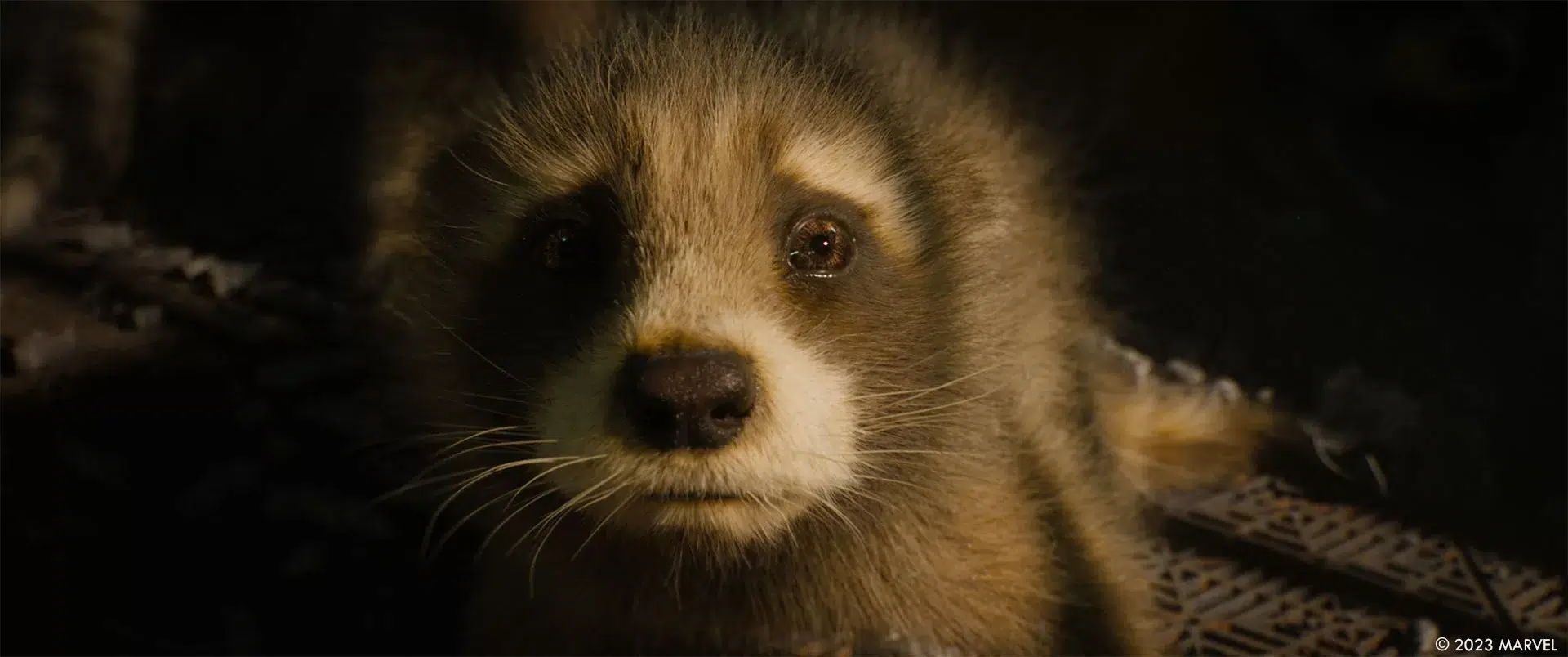
Can you describe this new collaboration with Director James Gunn?
It’s pretty much the same as it’s always been, except that he has done another many big movies in the meantime. So he’s an even sharper director than he ever was, he was really sharp already on the first Guardians. But he’s changed quite a bit in terms of the way he shoots stuff, he was already shooting quick on the first one, but he now is, is really fast and is is so sharp and prepared. We add a script that pretty much has not changed from from the moment we came in prep for the film. And he’s thumbnails, everything, he does storyboards of every single shot that is writing, and we will pick up from there and do previs on what we need to previs not everything. And we pretty much shoot to the film and that is written and we we edit the film that is written and it’s everything’s pretty linear in that way. It’s very, very well prepared and very contained. There’s no big swings or anything which makes it easier for visual effects because what we’re doing from the get go. And James is very on top of everything, he loves visual effects. And he likes working with the animators and is truly him. It’s just part of directing. And now he’s done all these movies with a lot of visual effects as well. So he’s even sharper with everything, every question we have, every issues with might have, we just figure it out really quickly. So it’s very good.
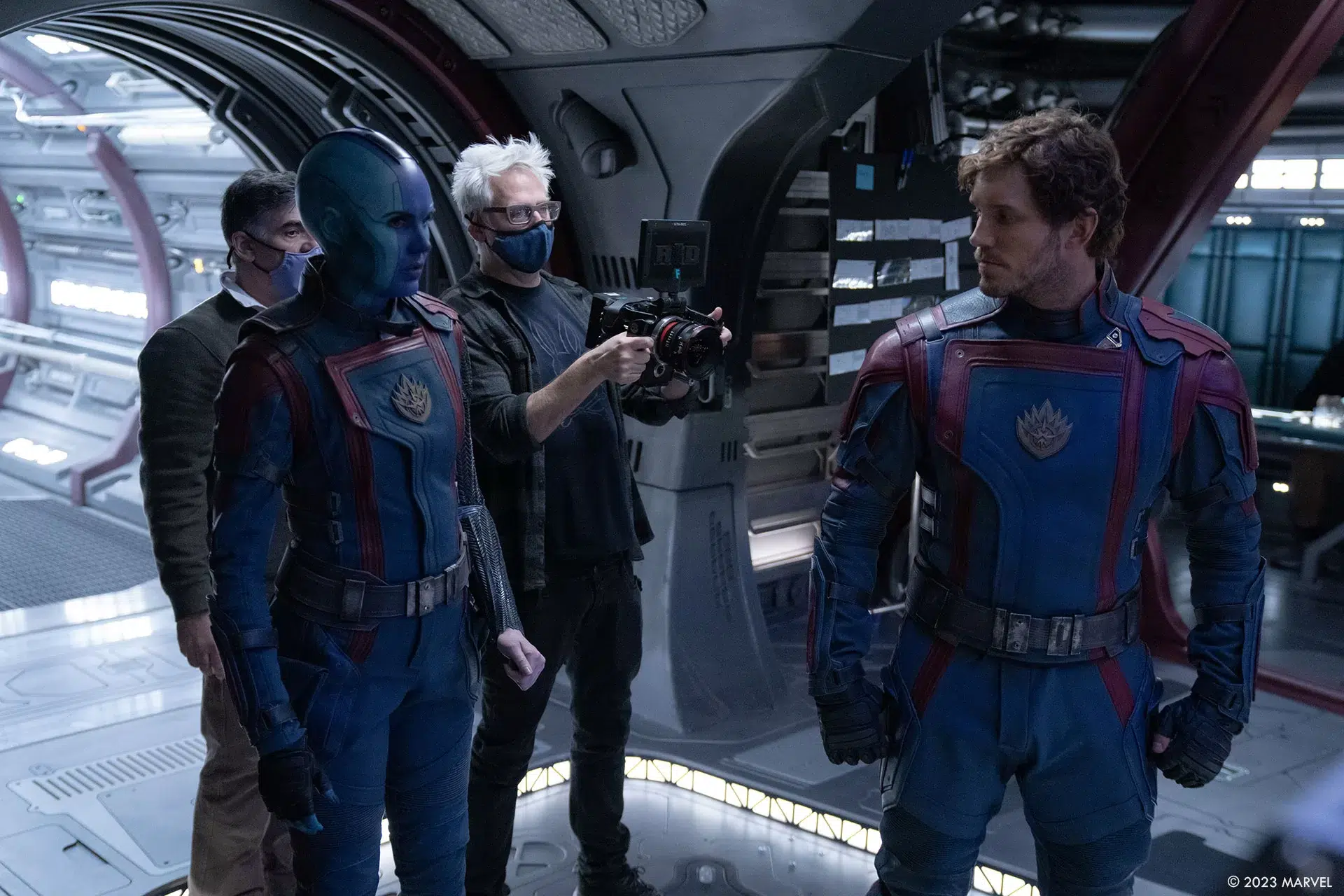
Can you explain us the evolution of Rocket and Groot since the 1st film until this last film?
Yeah. It’s not super different. For Rocket, we had to do all the different ages of Rocket. That was the difference as we have many more Rockets to do. And different versions of him. We had to tell the story of his evolution from that little kid that we see at the beginning of the film, in the cages, and all the way to the Rocket we know and to the moment he escapes, and then he grows after that keeps growing. So we have to understand the evolution of the character in every scene, every flashback that we see, it starts as a real raccoon, and then he gets experimented on and just tell the story of all these different phases of his experimentation with whatever contraptions and things that they’ve added to him, you can see different phases of that the film. That was interesting and the way we shot all the flashbacks, which is something we hadn’t done in the previous films, we use what we called a subset of a virtual production for the flashback scenes, which is what we shot the first few days of the film. We shot all the flashback scenes with the actors in a motion capture environment. But the idea there was not to shoot because the scenes would reach full CG in the cages. We knew that in the cages. It was I’m going to be for CG. And we did that for the cages and the scene in the white corridor when he goes to the afterlife. And so we decided to shoot that in virtual production environment, but not so much for the actors or for the characters but mostly for the cameras, because James has really changed his way of shooting. And with Henry Braham, our cinematographer, they’re using these very tiny RED cameras. With these stabilized head that they’re just carrying that. And so one of the key things that James wanted for all the story of Rocket was to be able to shoot the same way we shoot the rest of the film. So we shot with three cameras at the same time. And we motion captured the camera motion, so that we could actually get the footage with the actress acting, we had the real actors there, acting except for Rocket, we had Sean Gunn, but Sean always does Rocket on set. All of these scenes were filmed in the first few days of the shoot which was really great, because James wanted to give us as much time as possible to to make the scenes that are the emotional core of the film. And so we add those shots very early on in production. That was a little bit of a different process than what we had done usually in the, in the previous film, which was more like, what were the rest of the film was shot like that when Rocket is there amongst the actors, Quill and Gamora and Nebula and all these people we had, we always had Shawn with us doing Rocket on set and all that stuff that we had already done for the previous film.
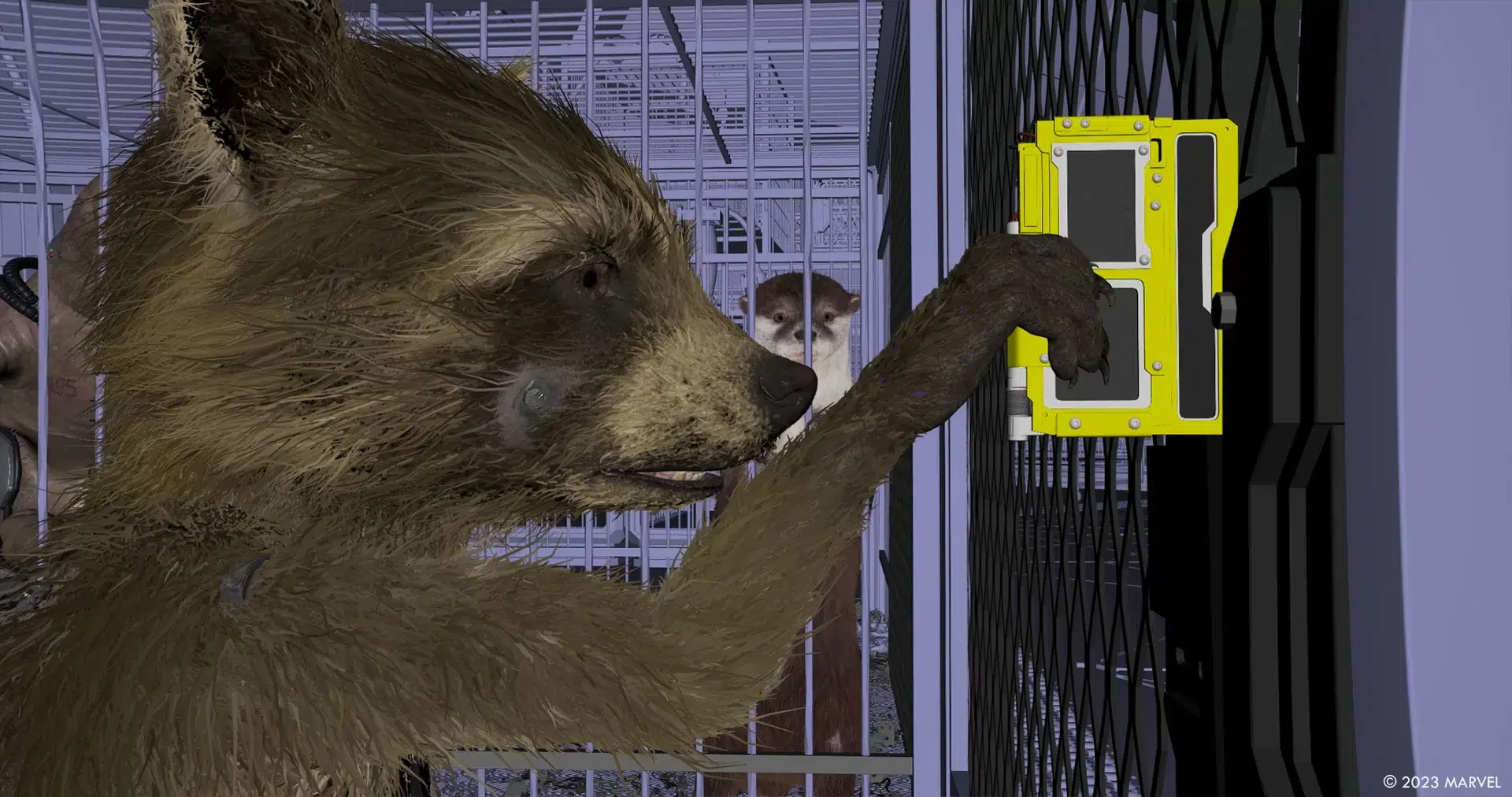
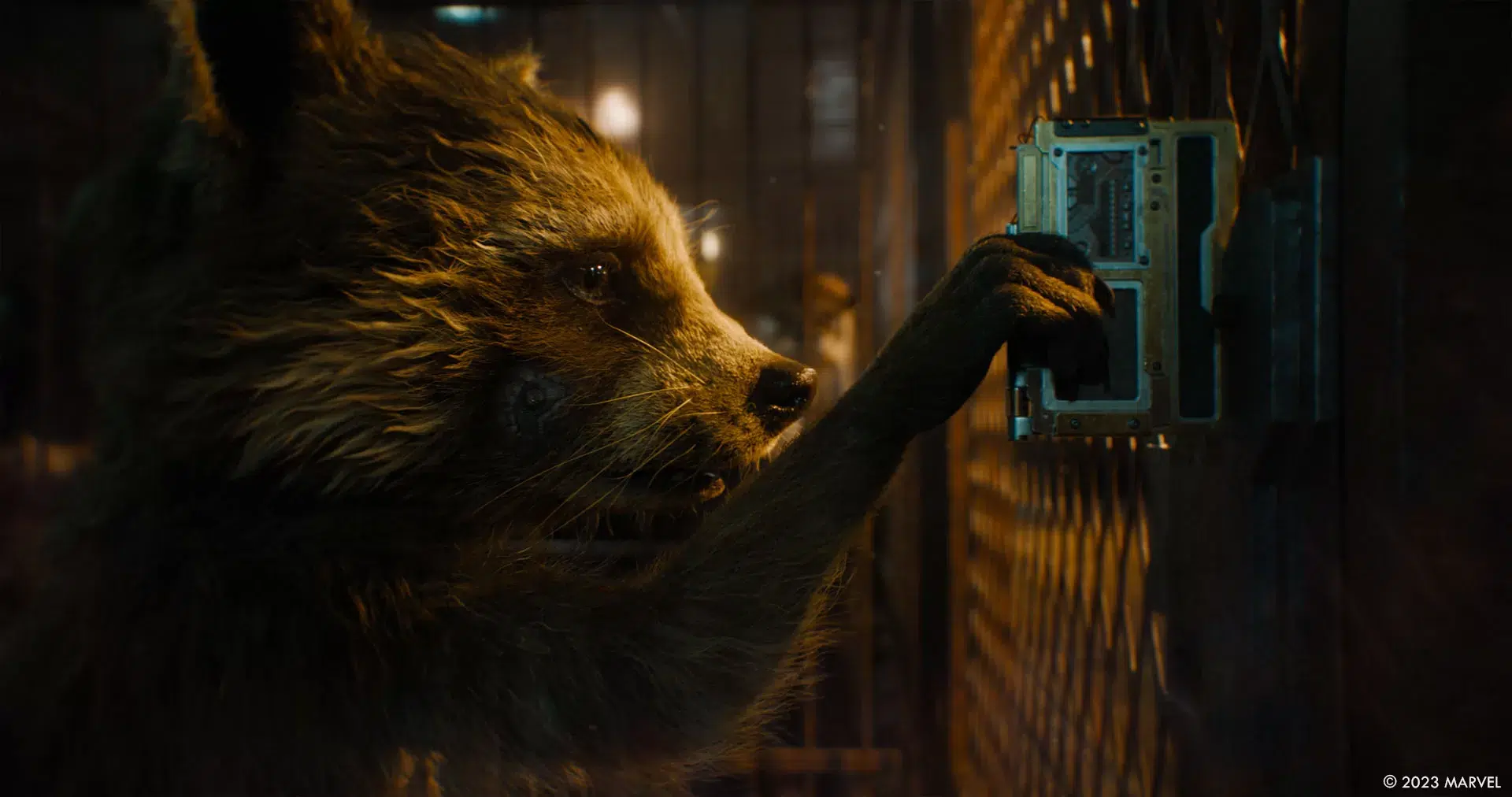
But for all the flashbacks, it was a totally different process this time. It’s still hand animated. Everything is hand animated. There’s no motion capture or retargeting or anything like that. So that hasn’t changed from the previous films. But we wanted to motion capture the cameras and give to the editors a scene they could edit and then pass to from postvis and then Framestore in the end. So that was the the singular thing that we did on this one was very specific about for the scenes. We looked at Rocket and his model has evolved across the different films because it went through different iterations and what I really wanted to bring back from the first film was in his face and his eyes, especially across the films that have happened since the first one, there was more and more white around these eyes. I don’t know why that happened. But there’s they added more white around his eyes. And that’s one thing we did on the first film, he was much more animalistic yet big, round, black eyes that were making that make made him look more like a raccoon, to be honest. And, so we brought that some of these features from the first film back because this is the film where he discovers is really a raccoon. So at the end he opens the cage and he sees that the cage where there was all these baby raccoons, he see a species sign with the mention “raccoon” so finally, what he has been denying during his entire life is true. He is a raccoon. And so we had to bring that back into his character as much as possible. And keep the animalistic nature of him. And we had all these shots very close up on the eyes and all that stuff. So we had to, update the fur and the detail on the eyes and the detail on the eyelids and all that stuff. We have so many hyper close ups on his eyes that we really yet give a lot of attention to that.
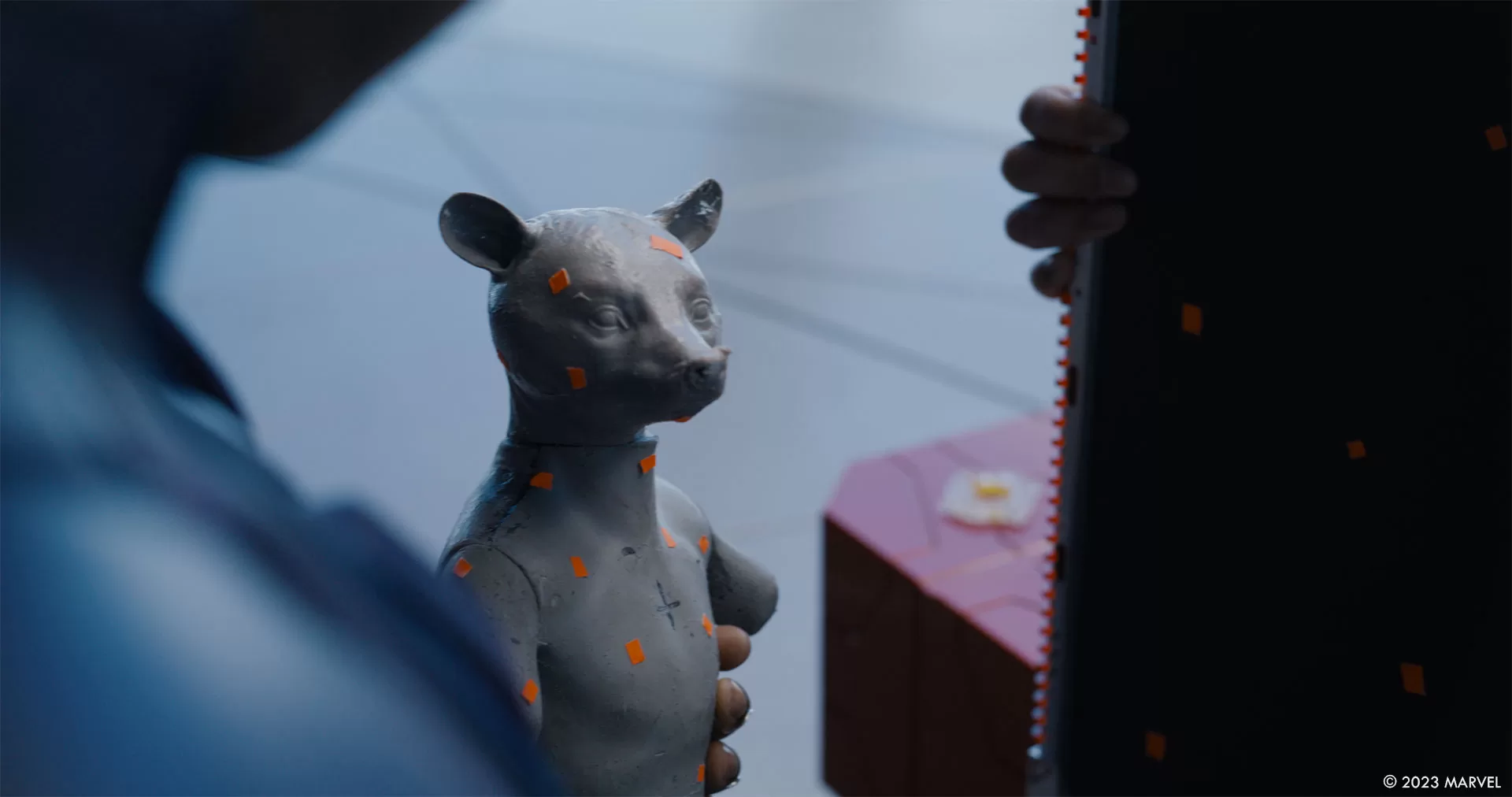
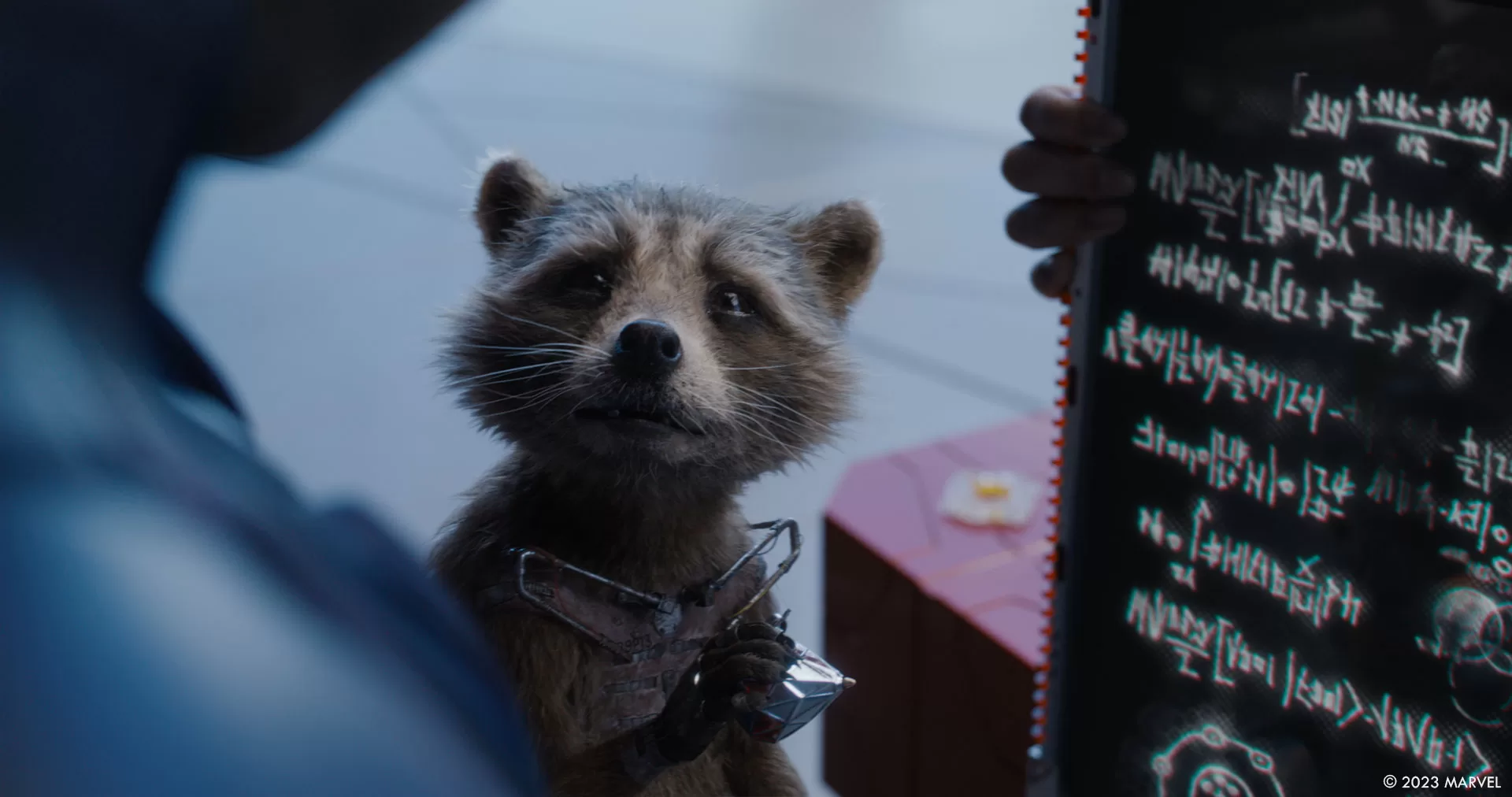
And for Groot, it was a little a little different process because Groot, in this movie, is the size of Peter Quill, roughly. So it’s the size of a human so we add a guy on set all the time called Austin Freeman, he was our Groot performer and we add him for most of the shots and we just put Groot on top of him which was really great for animation reference and and also for like the interaction obviously. For example when they go into the cars and open the doors and Groot sits down in the car. We had a real guy opening the door, going in the car so you can feel the weight of Groot coming into the car, all these things that would be difficult to do otherwise, but we just shot a lot of shots much more than we did on the first film because most of the time on the first film we ended up using the clean version without the the actors for Groot or Rocket. But in this one, we used the Groot performer much more in the shots. And that was really great most of the time. And, I mean, obviously, it’s very different is much more buff, there was a design that was done by VisDev, and then our friends from Legacy Effects created a sculpt of his bust so we could get a sense the size and everything and use that as a lighting reference on set.
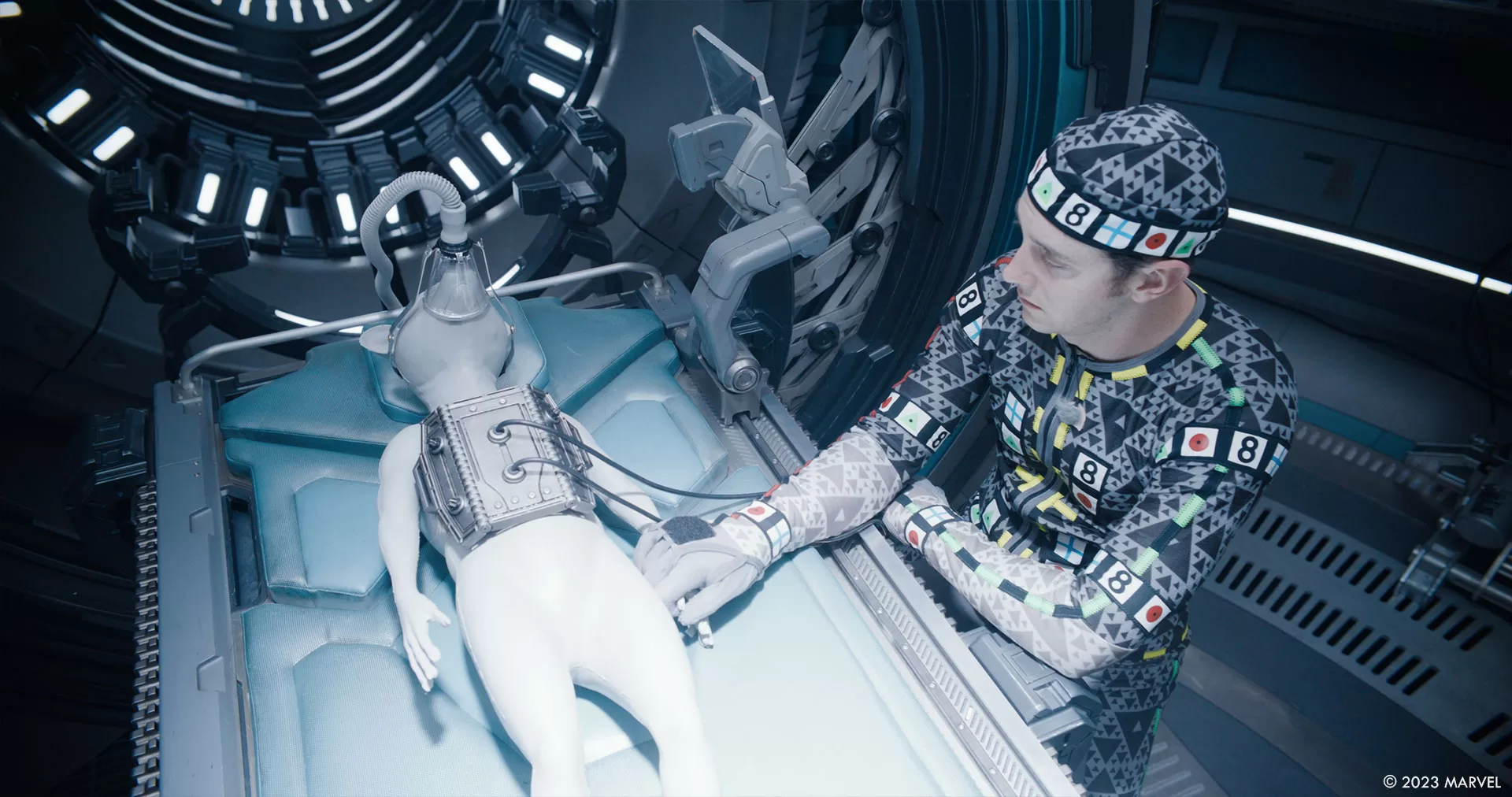
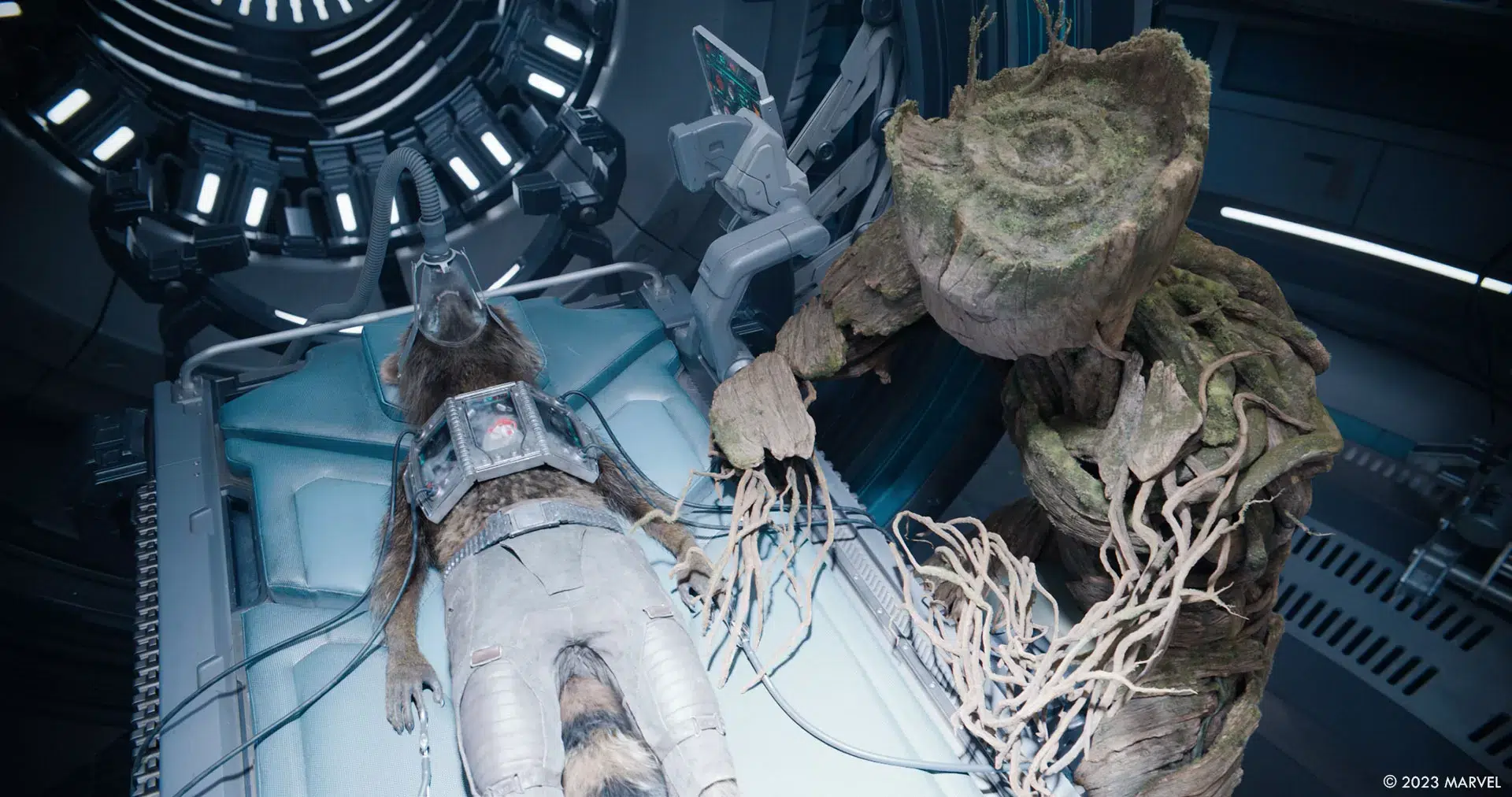
And the funny thing is that a lot of people were thinking when they saw the Holiday Special that it was a guy in a suit. But when you end up, which is for me, okay, good, it means that it looks real. We didn’t really get to see the advantage of that new design until the film itself when you see him kind of opening is his body, and there’s always the guns hidden inside, and he can grow his arms and everything. So there was a lot of things that we we kind of kept moving. And so it was fun to just like make it feel initially that there could be just a guy in a suit, but actually, no, it’s not. It’s much more than this. And he can do much more with his new body than he used to be able to do. And he is the son of Groot that we see the first movie.. So he is growing differently, he is going through a different growing phase than the old Groot did, is a little bit more bulky than the old Groot, which is fun, it’s a different vibe. And then we have him at the end in the tag sequence where it’s even bigger. It’s what we call in the Alpha Groot at that time. It’s much taller, it’s almost twice the size as everybody else. And and it’s fun to see that. Where is he going to stop? He’s really big now, really different from the old Groot for sure.
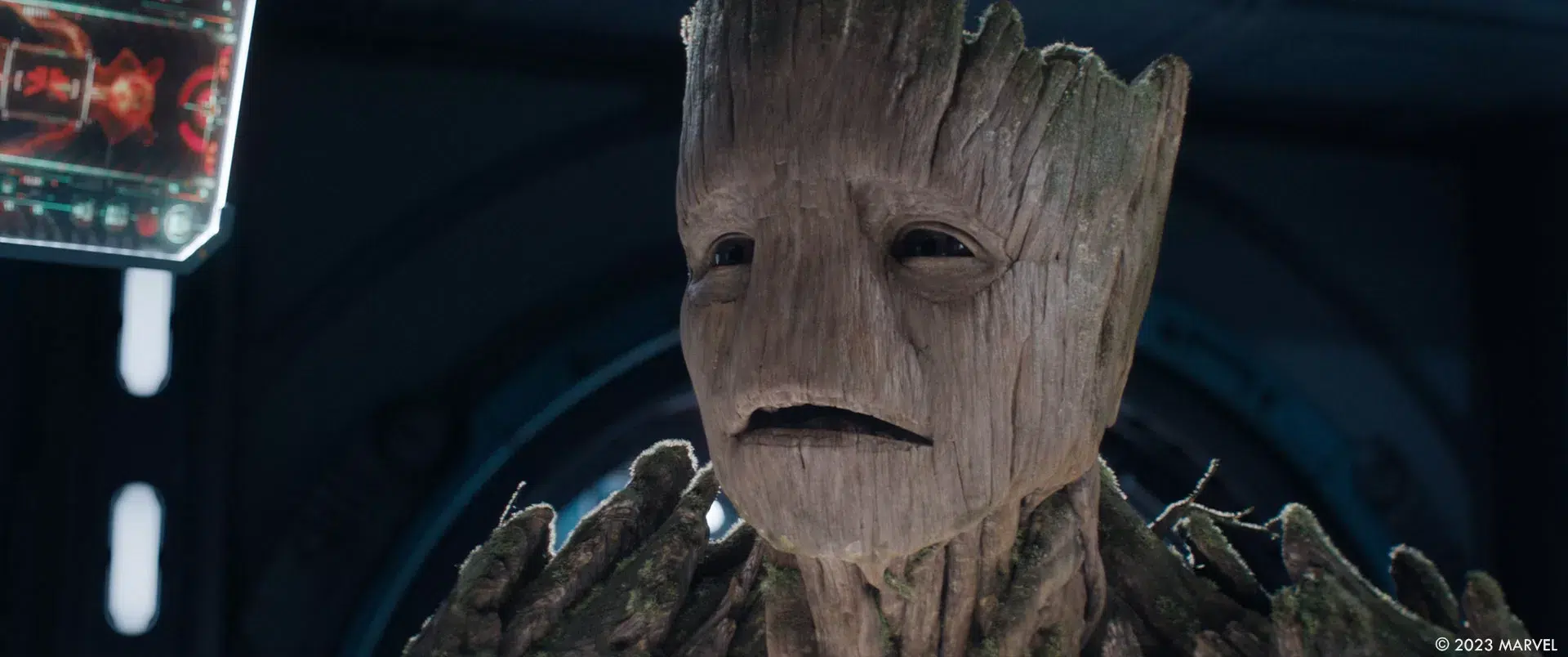
And I’ve got a tricky question. What’s your favourite moments with Rocket and Groot?
Oh, my God, it is a tricky question. Because there’s so many good moments, I think when Rocket goes and saves the little kids in the cages, and he sees them and he’s so emotional, and you understand that he’s a raccoon, and then he carries them, grabs them and puts them on his body and is about to save them. We don’t know Rocket as being very altruistic from what happened in the previous films. And it’s now shifting it to going to be that guy going to be altruistic and going to be saving not just his close friends, but he’s going to be saving everybody. And, that’s really a big shift in his journey as a person. And I think it’s a very cute moment. It’s beautiful, too. It’s a beautiful scene.
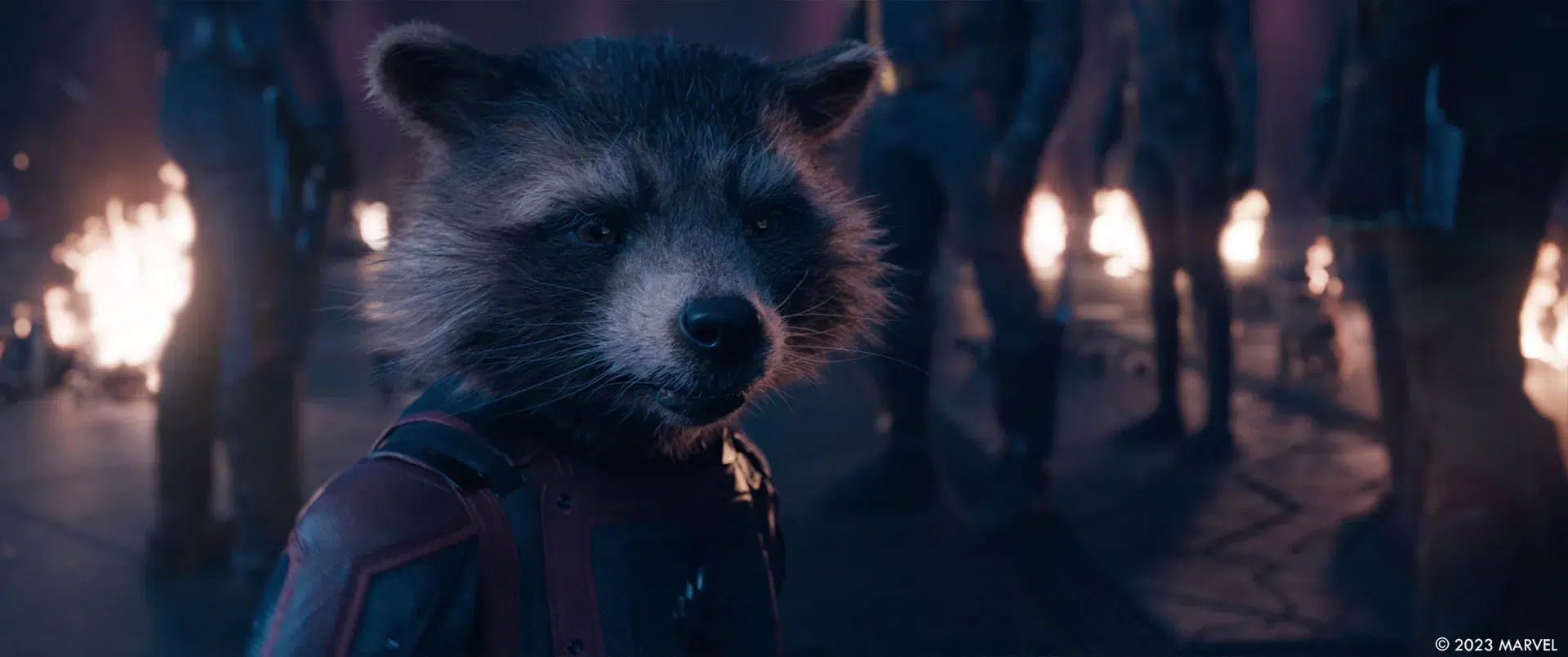
And I mean for Groot, I love a lot of moments. One of one of my favorite shot of Groot is actually towards the very end when Quill has finally landed on the Star Port in Knowhere after he’s been saved by Adam Warlock. And then there’s that group shot and is one shot where you see Groot kind of coming towards towards Quill, and he’s smiling, and he’s so happy that he’s alive. Because he was really, really afraid that he would die there. And that I think that’s just beautiful. It’s a beautiful shot. It’s the kindness of his face. I’ve always liked the kindness in the face of Groot. And then that specific moment is so kind and happy. I really liked that shot. There’s a flare coming in. And it’s kind of super quick shot, but it’s actually my favorite shot of Groot in there.
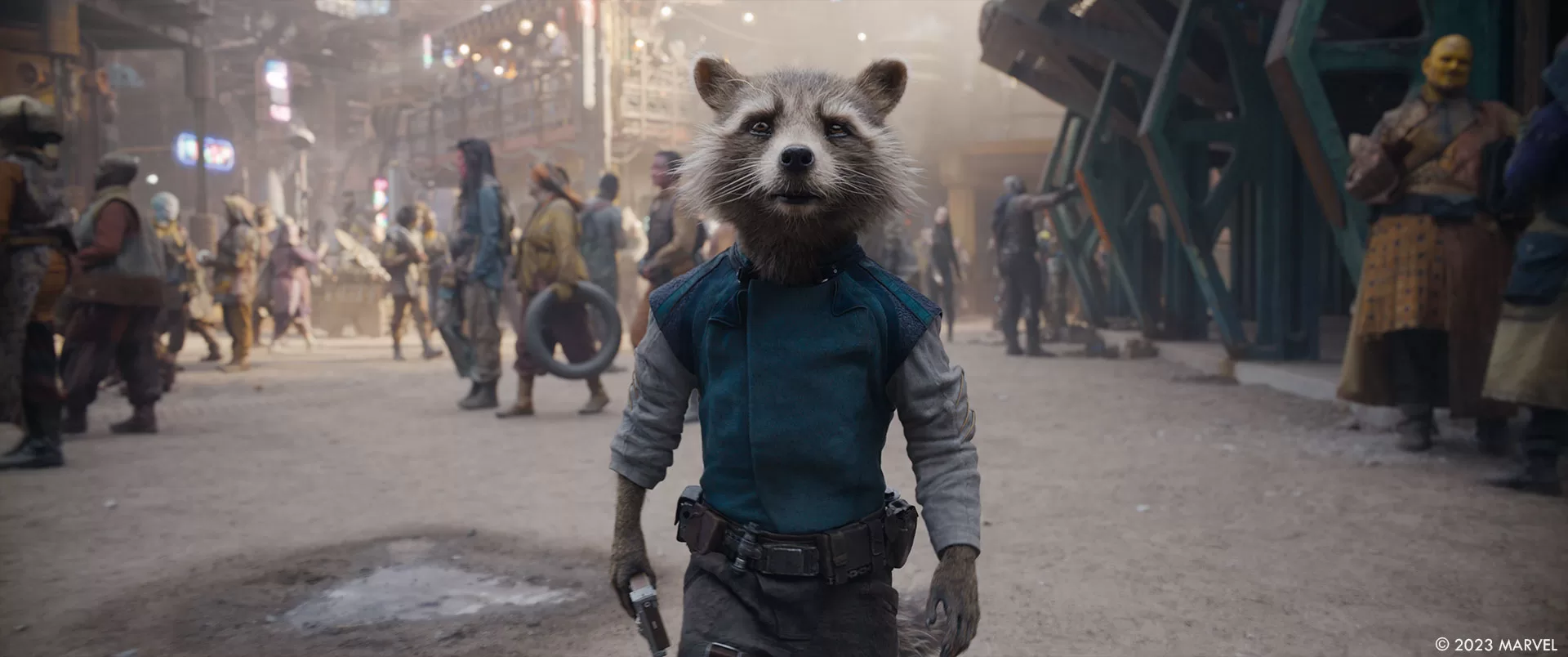
Let’s talk about the impressive oner. Can you elaborates about its filming and creation?
Well, we film that over almost three days. When you think about it’s two minutes of film and very complicated stuff. It’s not too bad. But still three days of filming is a big effort for one sequence. The story of it is that we tried to do something a little bit like that in the first film and we never quite had time to kind of figure it out and make it happen. That was always something in the back of the mind of James like I want to do this, I want to see them all fighting together. And that was the moment to do it, to see them fight together one last time. So, we add our fight coordinator, Wayne Dalglish, who had worked with James on the Peacemaker series was with us on this working also with Heidi Moneymaker, which is our stunt coordinator. And they saw Wayne kind of designed the sequence with James. He knows what beats that he wanted to hit in that corridor, and give a moment to each and every one of the characters working together. There was kind of a series of events that James really wanted to portray in that scene. So Wayne and his team worked on this for four or five months to kind of design it and do a lot of stunt-viz. And the good thing with Wayne is that he was doing stunt-viz on top of the previz. So they have a bit of of that going on, we tried to get our The Third Floor team to kind of do a little bit of tech vis but they were always it was so fast. They were doing stunt-viz that we could never catch up really. And it wasn’t really necessary to be honest.
We came on the day of shooting and we went in order of sequence because otherwise that would have been crazy. And we were doing stuff and then there was moments where it was getting a little scary with face replacement, we had to switch between digit double and, and real actors all the time. So we were kind of as we were shooting, and we were figuring out a lot of the connection points because obviously it wasn’t shot as one big shot, it was multiple pieces. And so we weren’t just chipping away through it, days after days of today’s but as as we’re going, you know, trying to find, okay, well, this is going to work fine. But then here, you need to put a cable on that person to get him thrown away. Okay, so that’s going to be our connection points. What can we use there, we were kind of not making it up as we go along. Because it was kind of really well prepared. But there was always little things that we’re learning as we’re going through it and shooting through it was like what actors could do and what stuntmen could do. And at what point we had to kind of switch between actors and stunts and digital doubles and all that stuff. It ended up being a sequence we gave it to our editor, Fred Raskin, who edited it pretty quickly.
Then, I went through it another time, once it was edited, with Wayne, and the guys at Weta FX. And then we had James coming in, and we were constantly looking at animation blocking, and it was a long process, it took us almost the full post to get it done. But mostly because we shot everything at 120 frames per second. Because we could then figure out when to do the speed ups and the slow downs. And in the route to the rhythm of the music as there was a song obviously on top of it. So we had to get the tempo of the music and the tempo of the animation to kind of match. So it was a long process, but it was really great. I mean, the guys at Weta FX were amazing, because they really took it and they match move the entire scene at 120 frames per second. So it was not two minutes, it was more like 12 to 15 minutes of match move. And then they started blocking every moment. And then we went through it with James, we were talking to each other pretty much every week. It was great moment. It was a lot of work. There’s a lot of digital going towards actors and then cameras positions that were not quite matching. So suddenly we go into a virtual set and then back into the photography and it’s super complicated. The Weta FX team just kill it!
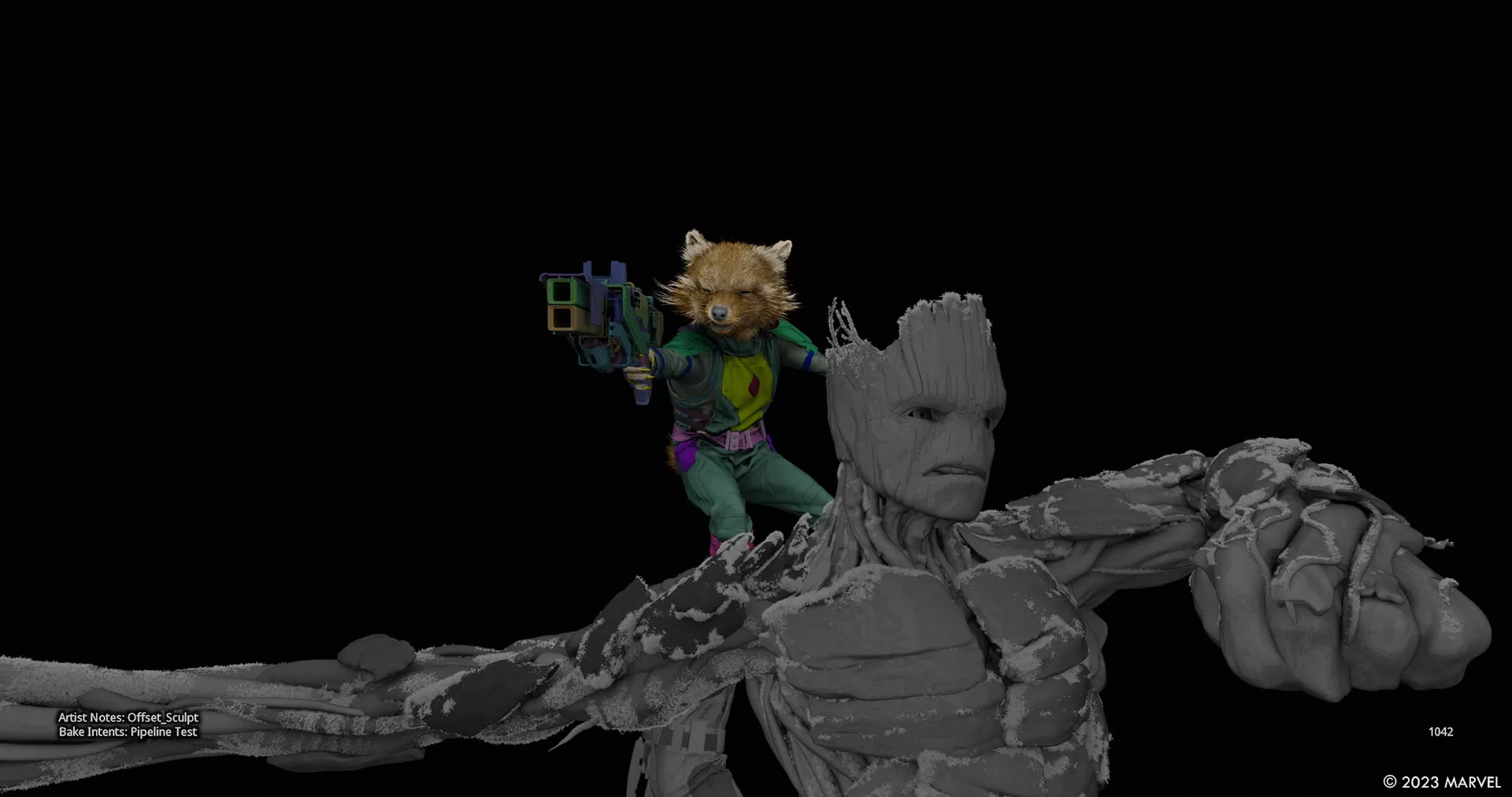
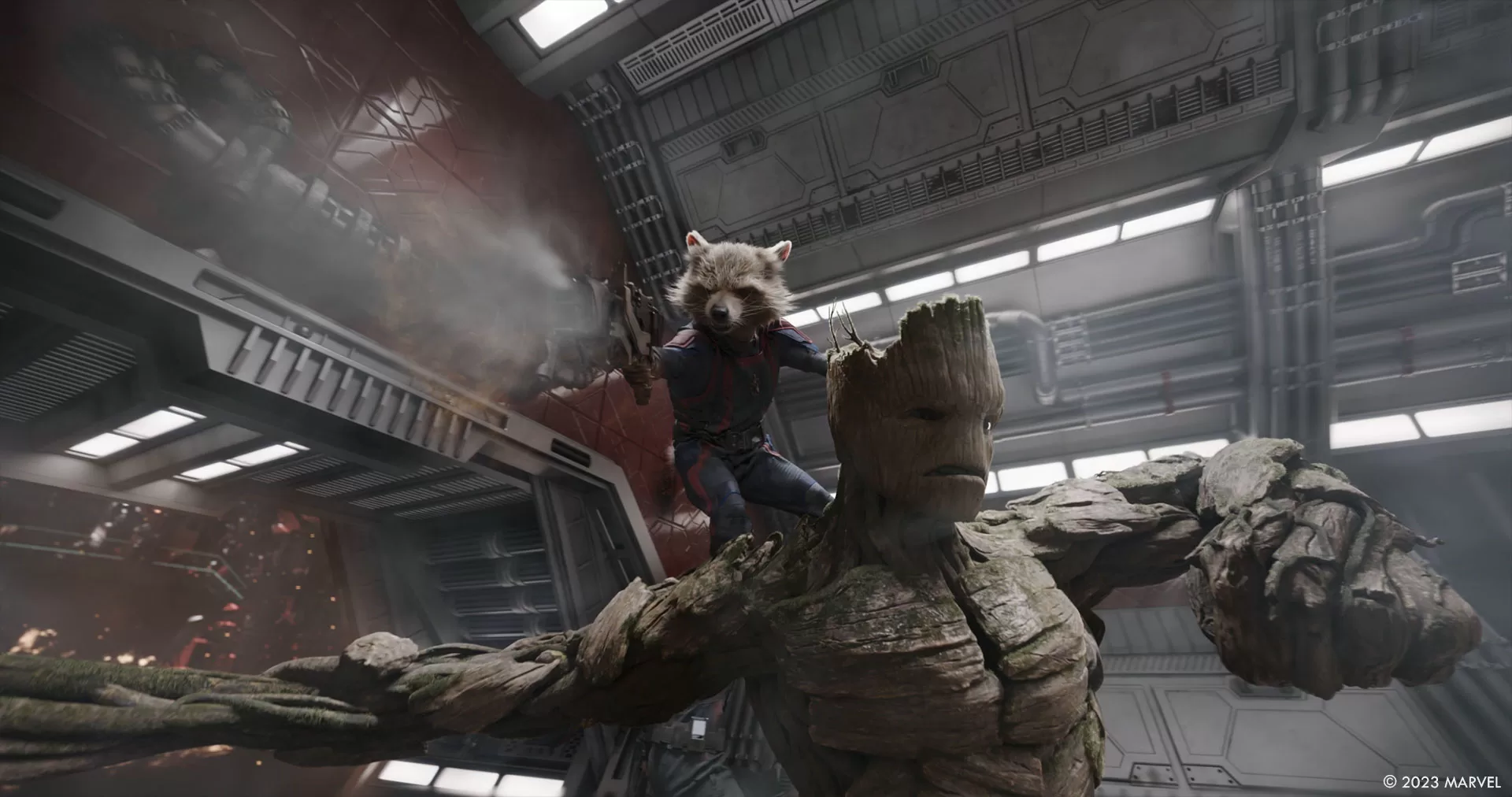
The trilogy is now over. What is your best memory of this saga?
Oh my god! I don’t know because we have so much fun on set. At when we shoot, it’s really crazy how much fun we have, like, the actors are solid, especially on this one. They were also tuned in to their characters because they’ve been doing them for a long time. And James, same thing, we’re doing, obviously everything’s written, but sometimes in the middle of the text, James is like “and you say this, and she says that” and then they go for it. And they kind of not really improv, but like, can bounce against each other. It’s hilarious. So we have a lot of fun. But I mean, one of the most emotional moment was the end the last day of shoot, because we were saying goodbye to everybody. One after the other. We were kind of cleaning up a little bit of the last few elements, we had to shoot with the actors and everything and it was Karen is done. Okay. Bye, Karen. And then and then Zoe is done. And then we finished with actually with Chris Pratt and he gave a very emotional speech that was really, really good. And then the last shot was a shot of, of Sean playing Rocket in the spaceship when he escapes from the Arete and that was the last shot, the last plate we shot it for at that time. Everybody was crying. Because that was it, that was the end, that was okay, we’re not doing this anymore. This is a goodbye to a lot of people that had been working together for 10 years. It was good, but very emotional.
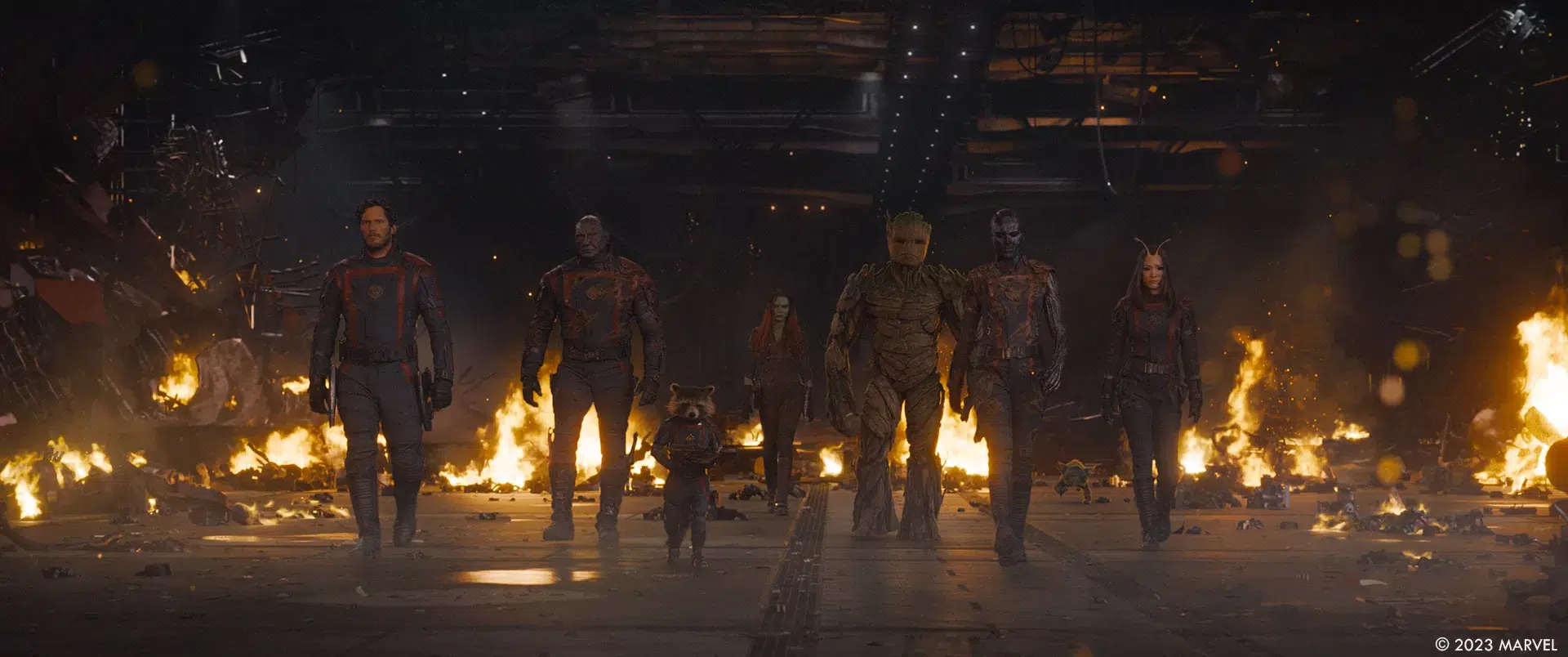
What’s coming next for you?
Oh, what’s next? Holidays!
A big thanks for your time.
WANT TO KNOW MORE?
Framestore: Dedicated page about Guardians of the Galaxy Vol. 3 on Framestore website.
Weta FX: Dedicated page about Guardians of the Galaxy Vol. 3 on Weta FX website.
© Vincent Frei – The Art of VFX – 2023





